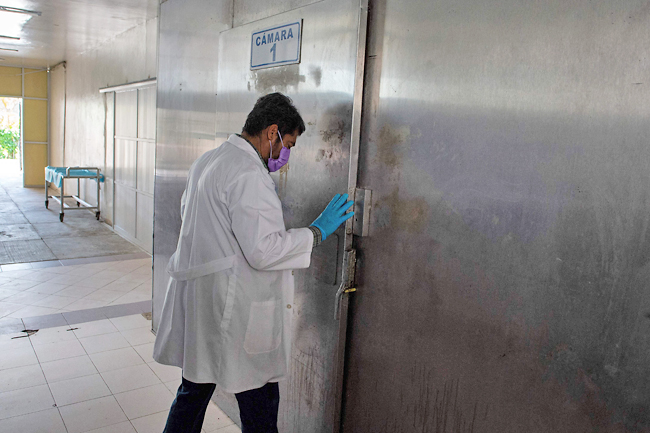MEXICO (AFP) – In a dark, windowless room with no air conditioning in southern Mexico, thousands of bones of unidentified people encapsulate the crisis of a forensic system overwhelmed by violent crime.
The morgue in Chilpancingo in Guerrero state is full of anonymous human remains – like many others in a country struggling to process a backlog of tens of thousands of bodies.
“The dead keep coming and people keep disappearing,” said a forensic anthropologist in Mexico City Nuvia Maestro.
On social media, Maestro declares her love for her cat Clementina – her “ray of light” – as well as cycling and colourful jackets.
At work, the 36-year-old uses two electric cooktops that she and her colleagues bought themselves to boil ribs to remove tissue and carry out tests to determine the age of the deceased. “You work and work and you don’t finish!” she said.
At the Chilpancingo morgue, incense burned by employees failed to mask the stench of death – or keep the flies away.

A forensic service worker browsed handwritten records of the remains, giving a shrug of the shoulders when asked why they are not digitised to facilitate relatives’ search for the missing.
The DNA studies “can take months”, frustrating families desperate to find their missing loved ones, said forensic service coordinator Alfonso Ramirez.
Mexico’s homicide rate has tripled since 2006 – when an intensification of the government’s war on drug cartels triggered a spiral of violence – from 9.6 murders per 100,000 inhabitants to 28 in 2021.
The number of people going missing has also increased sharply, from 265 in 2006 to 10,366 in 2021, and now totals 108,000 since records began in 1964.
Many victims are thought to have been buried by the authorities without being unidentified.
The government blames most of the deaths on gang violence.
Experts say the forensic crisis is also explained by the lack of funds, personnel, rapid DNA testing laboratories and a single genetic database.
The United Nations Committee on Enforced Disappearances estimates that, under current conditions, it would take 120 years to process the 52,000 unidentified bodies documented by the Movement for Our Disappeared, a non-governmental organisation.
Mexican authorities “do not have the institutional capacity to deal with the backlog” of unidentified bodies, a deputy minister responsible for human rights , Alejandro Encinas said in October.
Adding to the work of the forensic services, some criminals burn their victims’ corpses or bury them in clandestine graves.
The killers know which body parts are most useful for identification, such as fingertips, and destroy them, said Maestro, noting that the most abused corpses are those of women.
Regional forensic services budgets rose from USD110 million in 2015 to USD122 million in 2020, according to official data.
Over the same period, the average number of murders jumped from around 17 to 28 per 100,000 people.
Guadalupe Camarena, 62, cried clutching photos of her five missing children during an exhumation of remains at a graveyard in the western state of Jalisco.
Her daughter disappeared in the city of Guadalajara in 2016, followed by her four sons who vanished in 2019, allegedly after they were detained by police, the domestic worker said.
She hopes that giving a DNA sample will help her search for her five missing children.
“I don’t want to find them (dead) like this, but if I can’t find them alive…” she said, trailing off. The psychological impact of the situation forces experts such as Dalia Miranda, a municipal coordinator of exhumations in Jalisco, to undergo therapy. Forensic workers encounter “very ugly things”, she said.
It takes up to six months to compare DNA samples from remains with those of relatives of the missing, according to a university researcher in Guadalajara Alfonso Partida, whose morgue, he said, contains “tonnes” of remains.
The government has taken steps such as the creation of two centres for identification and four to store corpses. It is also working to establish a national identification center and a genetics laboratory to which the United States will contribute four million dollars.
But the attorney general’s office has yet to create a national forensic data bank stipulated by law.
In the meantime, Camarena visits the Guadalajara morgue every week to study pictures of the dead in her search for her children – a routine that she copes with using antidepressants.





